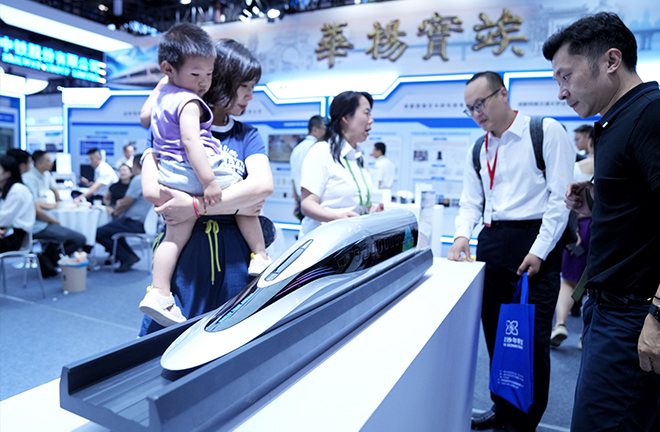China’s technological innovation trajectory: from imitation to independence

The 12th World Congress on High-Speed Rail and MODERN RAILWAYS 2025 were held concurrently in Beijing last week. At the event, China showcased its remarkable achievements in independent innovation in high-speed rail technology. Photo: IC PHOTO
Innovation serves as an essential source of national prosperity and a driving force for sustained economic development. In 2012, the 18th National Congress of the Communist Party of China proposed implementing the strategy of innovation-driven development, and China’s “Outline of the National Strategy of Innovation-Driven Development” came into effect in May 2016. Innovation in this context encompasses technological, institutional, and cultural dimensions. This article focuses specifically on China’s technological innovation, seeking to define the concept of Chinese-style technological innovation, explore its distinguishing features, trace its evolution, and examine the institutional mechanisms behind it.
Following-catching up-surpassing: evolution of Chinese-style innovation
Since the 2020s, Chinese scholars have put forward several representative interpretations of Chinese-style innovation. First, it is seen as a progression from learning and imitation to independent innovation, and from follower to peer to leader. Second, it fully capitalizes on China’s vast domestic market, primarily following a path of “introduction–digestion–absorption–reinvention,” with the dual aim of generating both economic and social value. Third, Chinese-style innovation is an integrative model of innovation, centered on four organically unified core elements: strategic orientation, comprehensiveness, openness, and synergy. Fourth, it is characterized by collective identification of market opportunities, rapid learning through trial-and-error, responsiveness to localized demand, product diversification, continuous technological upgrading, and cross-domain resource acquisition. Fifth, it is also described as a form of “secondary innovation”—that is, pursuing innovation in tandem with technology introduction, supported by ongoing interactive learning with technology sources, customers, and upstream and downstream partners across industry chains, thus fostering a sustainable innovation ecosystem.
Taken together, Chinese-style innovation can be understood as a model that leverages the comprehensive advantages of an emerging major economy and a new system for nationwide resource mobilization to promote industrial technological advancement, while transitioning from imitative to independent innovation. Over the long term, the evolutionary trajectory of Chinese-style innovation has progressed through three stages: technological following, catching-up, and surpassing. Influenced by goal-setting, pathway selection, and strategic priorities, these three stages may coexist at certain phases of innovation, though their relative significance varies.
Technological following refers to a stage in which, despite introduction, learning, and imitative innovation, domestic industrial technology still remains behind global leaders—as exemplified by China’s traditional automobile industry. Technological catching up describes a scenario in which introduction, learning, and cooperative innovation enable domestic industrial technologies to reach the level of developed countries—as seen in China’s color TV industry. Technological surpassing denotes a stage in which, through introduction, integration, and independent innovation, domestic industries rapidly reach the global technological frontier—as demonstrated by China’s high-speed rail industry.
Synergy between well-functioning government and efficient market
China’s system for nationwide resource mobilization harnesses the synergy between a well-functioning government and an efficient market to drive innovation, seamlessly integrating efficiency and effectiveness. Specifically, this involves the government setting technological innovation goals and plans based on national strategic needs and the requirements of socioeconomic development, formulating guiding policies and measures, and promoting investment in technology R&D, scientific and technological output, as well as industrial application and commercialization through allocation of R&D resources, intellectual property protection, and the construction of high-tech industrial parks.
Under the R&D project system, public funds are allocated to research institutes and enterprises through specific projects, driving investment in both capital and human resources. The system serves three core functions: guiding innovation activities in alignment with major national needs; distributing public research funding according to planned priorities; and enabling research teams to integrate and make efficient use of human, financial, and material resources.
China’s patent system has evolved from aligning with international standards to meeting the demands of high-quality domestic economic development and independent innovation, reflecting a strong sense of adaptation to changing times. As public awareness of innovation and the rule of law grows, and public consciousness of intellectual property protection increases, the Chinese patent system is transitioning from mandatory institutional change to induced institutional change.
High-tech industrial parks facilitate technological R&D and outcome incubation by concentrating innovation resources. Preferential policies—such as land-use approvals, infrastructure support, tax incentives, financial assistance, and subsidies—enable these high-tech development zones to attract high-quality national or regional resources and innovation factors. The resulting agglomeration and diffusion effects accelerate the flow of technological information, reduce transaction costs, yield increasing returns to scale, and, through diffusion to neighboring areas, strengthen regional innovation capacity and technological sophistication.
Ouyang Yao is a professor from the School of Economics at Zhejiang University.
Edited by WANG YOURAN

 PRINT
PRINT CLOSE
CLOSE